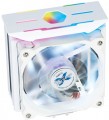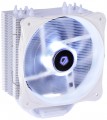Fan size
The diameter of the fan(s) used in the cooling system.
In general, larger fans are considered more advanced than smaller ones: they allow you to create a powerful air flow at a relatively low speed and low noise level. On the other hand, a large diameter means large dimensions, weight and price. As for specific figures,
40 mm and
60 mm models are considered miniature,
80 mm and
92 mm are medium,
120 mm and
135 /
140 mm are large, and even
200 mm fans are found in the most powerful
case systems.
Max. RPM
The highest speed at which the cooling system fan is capable of operating; for models without a speed controller (see below), this item indicates the nominal rotation speed. In the "slowest" modern fans, the maximum speed
does not exceed 1000 rpm, in the "fastest" it can be up
to 2500 rpm and even
more.
Note that this parameter is closely related to the fan diameter (see above): the smaller the diameter, the higher the speed must be to achieve the desired airflow values. In this case, the rotation speed directly affects the level of noise and vibration. Therefore, it is believed that the required volume of air is best provided by large and relatively "slow" fans; and it makes sense to use "fast" small models where compactness is crucial. If we compare the speed of models of the same size, then higher speeds have a positive effect on performance, but increase not only the noise level, but also the price and power consumption.
Max. air flow
The maximum airflow that a cooling fan can create; measured in CFM — cubic feet per minute.
The higher the CFM number, the more efficient the fan. On the other hand, high performance requires either a large diameter (which affects the size and cost) or high speed (which increases the noise and vibration levels). Therefore, when choosing, it makes sense not to chase the maximum air flow, but to use special formulas that allow you to calculate the required number of CFM depending on the type and power of the cooled component and other parameters. Such formulas can be found in special sources. As for specific numbers, in the most modest systems, the performance
does not exceed 30 CFM, and in the most powerful systems it can be up to 80 CFM and even
more.
It is also worth considering that the actual value of the air flow at the highest speed is usually lower than the claimed maximum; see Static Pressure for details.
Max. TDP
The maximum TDP provided by the cooling system. Note that this parameter is indicated only for solutions equipped with heatsinks (see "Type"); for separately made fans, the efficiency is determined by other parameters, primarily by the air flow values (see above).
TDP can be described as the amount of heat that a cooling system is able to remove from a serviced component. Accordingly, for the normal operation of the entire system, it is necessary that the TDP of the cooling system is not lower than the heat dissipation of this component (heat dissipation data is usually indicated in the detailed characteristics of the components). And it is best to select coolers with a power margin of at least 20 – 25% — this will give an additional guarantee in case of forced operation modes and emergency situations (including clogging of the case and reduced air exchange efficiency).
As for specific numbers, the most modest modern cooling systems provide TDP
up to 100 W, the most advanced —
up to 250 W and even
higher.
replaceable
The ability
to replace a regular fan by the user himself — without contacting a service centre or repairmen. The maximum that may be required for such a procedure is the simplest tools like a screwdriver; sometimes they are even initially included in the cooling system kit.
The fan, as the most mobile part of any cooling system, is more prone to breakdowns and failures than other parts. In cases like this, it's cheaper (and often smarter) to replace just that part rather than buying a whole new system. Also, if desired, you can change a working fan — for example, to a more powerful or less noisy one.
Lighting colour
The colour of the backlight installed in the cooling system.
See above for more details on the backlight itself. Also note here that in the illumination of modern cooling systems there is both one colour (most often
red or
blue, less often
green,
yellow,
white or
purple), and multi-colour systems such as
RGB and
ARGB. The choice of a single-colour backlight depends mainly on aesthetic preferences, but the last two varieties should be touched upon separately.
The basic principle of operation of both RGB and ARGB systems is the same: the design provides for a set of LEDs of three basic colours — red (Red), green (Green) and blue (Blue), and by changing the number and brightness of the included LEDs, you can not only intensity, but and tint of light. The difference between these options differs in functionality: RGB systems support a limited set of colours (usually up to one and a half dozen, or even less), while ARGB allows you to choose almost any shade from the entire available colour range. At the same time, both of them can support backlight synchronization (see below); in general, this function is not required for RGB and ARGB systems, but it is used almost exclusively in them.
Noise level
The standard noise level generated by the cooling system during operation. Usually, this paragraph indicates the maximum noise during normal operation, without overloads and other "extreme".
Note that the noise level is indicated in decibels, and this is a non-linear value. So it is easiest to evaluate the actual loudness using comparative tables. Here is a table for values found in modern cooling systems:
20 dB — barely audible sound (quiet whisper of a person at a distance of about 1 m, sound background in an open field outside the city in calm weather);
25 dB — very quiet (normal whisper at a distance of 1 m);
30 dB — quiet (wall clock). It is this noise that, according to sanitary standards, is the maximum allowable for constant sound sources at night (from 23.00 to 07.00). This means that if the computer is planned to sit at night, it is desirable that the volume of the cooling system does not exceed this value.
35 dB — conversation in an undertone, sound background in a quiet library;
40 dB — conversation, relatively quiet, but already in full voice. The maximum permissible noise level for residential premises in the daytime, from 7.00 to 23.00, according to sanitary standards. However, even the noisiest cooling systems usually do not reach this indicator, the maximum for such equipment is about 38 – 39 dB.
Heatsink material
—
Copper. Copper has a high thermal conductivity and provides efficient heat dissipation, but such radiators are quite expensive.
—
Aluminium. Aluminium is cheaper than copper, but its thermal conductivity, and, accordingly, its efficiency is somewhat lower.
—
Aluminium/copper. Combined design — usually, a radiator is made of aluminium, and heat pipes are made of copper. This combination achieves good performance without a significant increase in cost. This type of heatsink applies only to active coolers.
Socket
Socket type - socket for CPU - with which the corresponding cooling system is compatible.
Different sockets differ not only in compatibility with a particular CPU, but also in the configuration of the seat for the cooling system. So, when purchasing a processor cooling system separately, you should make sure that it is compatible with the socket. Nowadays, solutions are produced mainly for the following types of sockets:
AMD AM2/AM3/FM1/FM2,
AMD AM4,
AMD AM5,
AMD TR4/TRX4,
Intel 775,
Intel 1150,
Intel 1155/1156,
Intel 1366,
Intel 2011/2011
v3,
Intel 2066,
Intel 1151/1151 v2,
Intel 1200,
Intel 1700.

